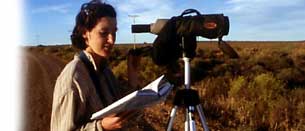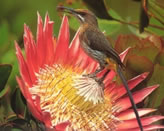|
|
Select
Specials: Bushmanland
Burchell’s
Courser
This
endemic is undoubtedly the most frequently missed special
in Bushmanland, and its elusiveness is attributable to its
nomadic tendencies and low population density. The best places
to search for it, and the recommended strategies, are given
on p.90. In the non-breeding season, large nomadic groups
may be seen in almost any open area. While today it is very
much associated with arid areas from the Namib to the Karoo,
the bird wanders widely, and small numbers move in winter
into the higher-rainfall wheatlands of the southwestern Cape,
and into the grasslands of eastern South Africa. It was once
even described as regular in western KwaZulu-Natal, although
it no longer occurs there.
Red Lark
This
little-known bird, whose nest was only discovered as recently
as 1986, is the only species whose global range is totally
restricted to Bushmanland. It is, however, reasonably common
in its localized sandy habitat. Red Lark occurs in a number
of colour forms, though recent research has shown that these
are not sufficiently different from each other to warrant
individual species status. Generally speaking, the rich reddish-backed
‘dunes form’ occurs on the red dunes in the northwest
of the region near Aggenys (see p.95), while the browner-backed
‘plains form’ is found in the east of the region
(around Brandvlei for instance; see p.89). The males engage
in conspicuous aerial displays, during which they call frequently.
Sclater’s Lark
Largely
restricted to this region, Sclater’s Lark is one of the
enigmatic specials of Bushmanland. Suggestions on finding
this inconspicuous bird, and its habitat preferences, are
offered on p.91. It is unique among local larks in that it
lays only one egg, a phenomenon shared by several other unrelated
species (such as Double-banded Courser and Karoo Korhaan)
that co-habit its harsh habitat. Parent birds undergo huge
thermal stress while sitting on the nest, which is situated
on exposed rocky plains. Once the egg has hatched, small stones
are placed in the nest to break up the chick’s shape
and add to the camouflage. Although still locally somewhat
nomadic, artificial stock-watering points on farms must have
benefited this species as, conveniently for birders, it needs
to drink regularly.
Black-eared Finchlark
This
is a characteristically nomadic species that moves around
in large numbers in response to rain and often irrupts into
areas where the grass is seeding. Care needs to be taken in
identifying the females, which may resemble other larks and
finchlarks. Breeding must occur rapidly due to limited favourable
conditions, and males hover butterfly-like during their characteristic
display flights. The nest cup, lined with grass and distinctively
surrounded by an earth and spider-web mix, is usually built
at the base of a small shrub. Curiously for a lark, this species
sometimes nests in loose colonies.
|
This website is maintained by Birding Africa.
Please do not use any text, images or content from this site without
permission.
© Birding Africa 1997-2009 info@capebirdingroute.org
4 Crassula Way, Pinelands, 7405, Cape Town, South Africa
|

27/09/09: Dalton
Gibbs reports back from Gough
Island! Read the blog!
26/09/09: New Cape
Town Pelagics trip report from trips of 12 and 19 September
2009.
30/08/09: British
Birdwatching Fair at Rutland Water proved very successful,
with sunny weather and over 20,000 visitors. Callan's "Birding
Namibia and the Okavango" was the most highly-attended
lecture on the Saturday, with over 240 people. Congratulations
to the winners of the Birding Africa competition and the
African Bird Club raffle that we helped sponsor!
12/08/09: New Cape
Town Pelagics trip reports from August and July 2009.
Highlights: Little
Shearwater and more!
07/08/09: The
sub-adult Black Sarrowhawk visits our garden again! Read
on about Raptor Research in the Western Cape.
27/07/09: Cape
Town's Verreauxs' Eagle Chick has grown! And its sibling
never had a chance to hatch. See the pictures of the chick,
its nest and the breeding pair. Find out more about the Western
Cape Raptor Research Programme.
27/07/09: To follow modern nomenclature and systematics, we've
adopted the IOC
World Bird List, Version 2.1.
13/07/09: The 8th
African Bird ID Challenge has launched! Win a 50% discount
on a Cape Town Pelagics
trip, a copy of Southern
African Birdfinder, or African
Bird Club membership for 1 year.
6 July 09: Cape
White-eye research in our garden.
2 July 09: Cape
Town's Verreauxs' Eagle Chick has hatched! See the pictures
of the chick, its nest and the breeding pair. Find out more
about the Western Cape Raptor Research Programme.
2 July 09: Campbell
Fleming, a Cape Town scholar, avid birder and photographer,
joined Birding Africa last month as an intern. Click here,
to see what he got up to.
2 July 09: New pelagic
trip reports from the Cape Town Pelagics trips in June
2009. Highlights: Slenderbilled
Prion and Leach's Storm Petrel
30 july 09: Our latest Cape Fynbos and Karoo trip
reports feature Hottentot
Buttonquail, Cinnamon-breasted
Warbler and other fynbos and Karoo endemics...
26 June 09: Tungsten
mining threatens RAMSAR site, South Africa's Verlorenvlei.
Read the Media Release.
22 June 09: Claire
Spottiswoode, one of the Cape Birding Route founders,
was part of the exploratory team at Mount Mabu. The mountain
is part of the newly discovered largest
rainforest in Southern Africa.
11 June 09: A colour-ringed
Black Sparrowhawk visits the Birding Africa office garden.
Read why it's a 10 months old male!
14 June 09:
Wildlife
at the office of The Cape Birding Route, Birding Africa
and Cape Town Pelagics.
31 May 09:
Michel Watelet wins the 7th African Bird Club & Birding Africa
ID Challenge. Test your African birding skills and WIN
a Birding
Africa Cape town day trip or a copy of the Birdfinder!
30 May 09:
A tragedy unfolds at Kommetjie south of Cape town as 44 beached
False
Killer Whales were shot. Click here for more details and
pictures.
14 March 09: Raptor
Watch in Cape Town on 14 March 09
|
|


